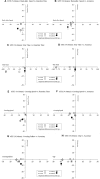Cognitive-Motor Interference in an Ecologically Valid Street Crossing Scenario
- PMID: 29774001
- PMCID: PMC5944128
- DOI: 10.3389/fpsyg.2018.00602
Cognitive-Motor Interference in an Ecologically Valid Street Crossing Scenario
Abstract
Laboratory-based research revealed that gait involves higher cognitive processes, leading to performance impairments when executed with a concurrent loading task. Deficits are especially pronounced in older adults. Theoretical approaches like the multiple resource model highlight the role of task similarity and associated attention distribution problems. It has been shown that in cases where these distribution problems are perceived relevant to participant's risk of falls, older adults prioritize gait and posture over the concurrent loading task. Here we investigate whether findings on task similarity and task prioritization can be transferred to an ecologically valid scenario. Sixty-three younger adults (20-30 years of age) and 61 older adults (65-75 years of age) participated in a virtual street crossing simulation. The participants' task was to identify suitable gaps that would allow them to cross a simulated two way street safely. Therefore, participants walked on a manual treadmill that transferred their forward motion to forward displacements in a virtual city. The task was presented as a single task (crossing only) and as a multitask. In the multitask condition participants were asked, among others, to type in three digit numbers that were presented either visually or auditorily. We found that for both age groups, street crossing as well as typing performance suffered under multitasking conditions. Impairments were especially pronounced for older adults (e.g., longer crossing initiation phase, more missed opportunities). However, younger and older adults did not differ in the speed and success rate of crossing. Further, deficits were stronger in the visual compared to the auditory task modality for most parameters. Our findings conform to earlier studies that found an age-related decline in multitasking performance in less realistic scenarios. However, task similarity effects were inconsistent and question the validity of the multiple resource model within ecologically valid scenarios.
Keywords: aging; cognitive-motor interference; dual-tasking; ecological validity; multitasking; street crossing; virtual reality; walking.
Figures




Similar articles
-
The association of executive functions and physical fitness with cognitive-motor multitasking in a street crossing scenario.Sci Rep. 2023 Jan 13;13(1):697. doi: 10.1038/s41598-022-26438-x. Sci Rep. 2023. PMID: 36639402 Free PMC article.
-
Street crossing behavior in younger and older pedestrians: an eye- and head-tracking study.BMC Geriatr. 2015 Dec 29;15:176. doi: 10.1186/s12877-015-0175-0. BMC Geriatr. 2015. PMID: 26714495 Free PMC article.
-
Walking and talking: dual-task effects on street crossing behavior in older adults.Psychol Aging. 2011 Jun;26(2):260-268. doi: 10.1037/a0021566. Psychol Aging. 2011. PMID: 21401262 Free PMC article.
-
The ecological approach to cognitive-motor dual-tasking: findings on the effects of expertise and age.Front Psychol. 2014 Oct 14;5:1167. doi: 10.3389/fpsyg.2014.01167. eCollection 2014. Front Psychol. 2014. PMID: 25352820 Free PMC article. Review.
-
A narrative review of texting as a visually-dependent cognitive-motor secondary task during locomotion.Gait Posture. 2017 Feb;52:354-362. doi: 10.1016/j.gaitpost.2016.12.027. Epub 2016 Dec 22. Gait Posture. 2017. PMID: 28043057 Review.
Cited by
-
Virtual Reality Expands the Toolkit for Conducting Health Psychology Research.Soc Personal Psychol Compass. 2021 Jul;15(7):e12606. doi: 10.1111/spc3.12606. Epub 2021 May 15. Soc Personal Psychol Compass. 2021. PMID: 36325429 Free PMC article.
-
Performance in complex life situations: effects of age, cognition, and walking speed in virtual versus real life environments.J Neuroeng Rehabil. 2021 Feb 8;18(1):30. doi: 10.1186/s12984-021-00830-6. J Neuroeng Rehabil. 2021. PMID: 33557894 Free PMC article.
-
Behavioural risk models explain locomotor and balance changes when walking at virtual heights.J R Soc Interface. 2025 May;22(226):20240832. doi: 10.1098/rsif.2024.0832. Epub 2025 May 14. J R Soc Interface. 2025. PMID: 40359970
-
Differences in Cognitive-Motor Interference in Older Adults While Walking and Performing a Visual-Verbal Stroop Task.Front Aging Neurosci. 2019 Jan 9;10:426. doi: 10.3389/fnagi.2018.00426. eCollection 2018. Front Aging Neurosci. 2019. PMID: 30687077 Free PMC article.
-
The association of executive functions and physical fitness with cognitive-motor multitasking in a street crossing scenario.Sci Rep. 2023 Jan 13;13(1):697. doi: 10.1038/s41598-022-26438-x. Sci Rep. 2023. PMID: 36639402 Free PMC article.
References
LinkOut - more resources
Full Text Sources
Other Literature Sources

